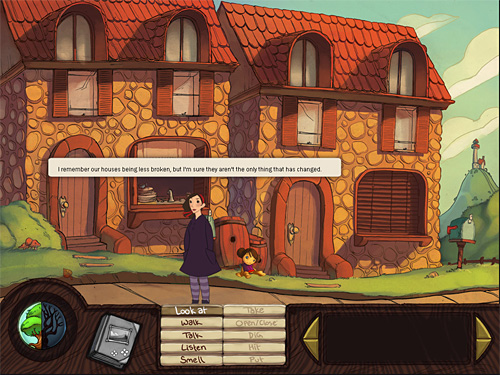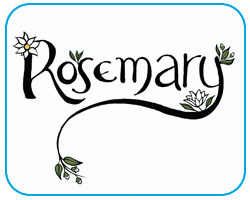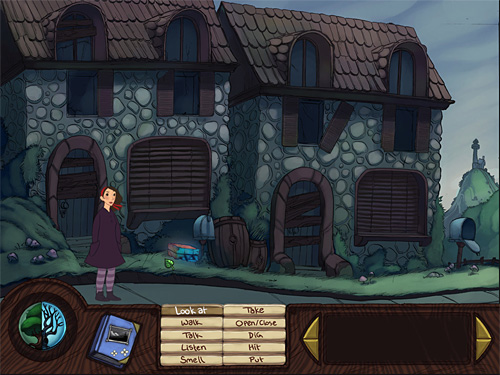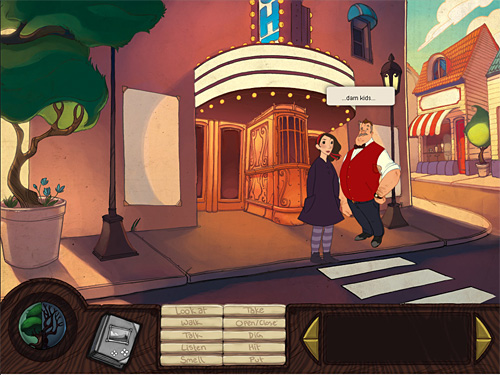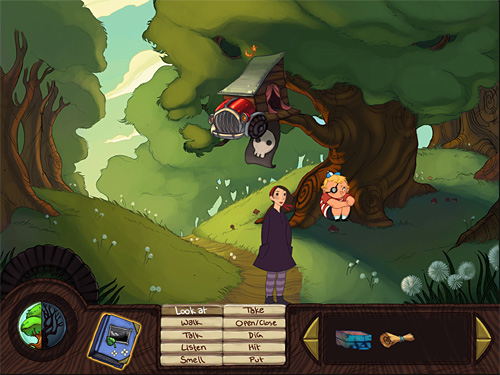 |

This page contains all entries posted to GAMBIT in June 2009. They are listed from oldest to newest.
May 2009 is the previous archive.
July 2009 is the next archive.
Many more can be found on the main index page or by looking through the archives.
|
 |
June 24, 2009 5:50 PM
Announcing the Spring 2009 GAMBIT Games!
June 24, 2009 6:00 PM
Introducing Rosemary
During the past academic year, I had the pleasure to work with a group of very talented students on a new GAMBIT game, Rosemary. It's been an exercise in nostalgia: nostalgia as a theme in the game, and nostalgia for a genre that had its heyday more than 15 years ago.
Rosemary is a point-and-click adventure game whose core mechanic is remembering events of the past in order to uncover a mystery. The protagonist, Rosemary, has discovered a photo of her childhood friend Tom, whom she had come to believe was imaginary. Determined to find out what happened to him, she returns to her hometown of New Rye. Her memories of the place are all she has in order to find Tom.
Rosemary is a game about returning to the place where one grew up, but haven't been back to in a long time. As in real life, buried memories resurface when the player revisits such places, changing how one perceives the location. Part of these game mechanics were based on Quintillian's Memory Palaces, where arranging one's memories in a space is what facilitates remembering people, events and facts in a speech. You can read more about the premise of the game and a short statement on the game's homepage. Rather than having me spoil the game any further, please just go ahead and play it. It's rather short, especially if you've played adventure games before.
At GAMBIT we research games, and we learn by making them and thinking about the whole process. What follows are four of the things that I learned while making Rosemary.
1. We Need to Support Story TrackingWhen I proposed this game, I was well aware that we would not be able to follow the development methods and timelines that had worked well for previous games made at GAMBIT. An adventure game requires not only a set of mechanics but also a fleshed-out story, and that takes time. Having everybody in the team know the story well is an additional challenge. As the story grows and changes while the game is being developed, it becomes increasingly difficult to keep all team members on the same page, which is critically important since the story is intertwined through every aspect of the game. When a game is made by one person, or a small team of people working in close proximity, the unified vision is relatively easier to keep. When the developers are a team of students with disparate schedules who are only available to work 10 hours a week, maintaining a unified vision becomes a serious problem. Nobody re-reads the design document (remember: we don't have that much time), so the story evolves but not in a unified way.
I was lucky to work with a team of very talented and engaged students who not only lived up to the challenge but did a great job of working together and getting things done. However, there were some issues resulting from this work situation which could have been palliated with tools to keep track of the story of the world and its audiovisual representations. This experience has provided me with a new research goal: developing tools that will help teams working on story-based games by keeping track of the story and structuring and relating the information effectively.
2. Interaction Design and Writing are Related But Different Parts of DevelopmentOver the course of development, our designer, Sarah Sperry, served as both writer and designer. Although writing and design go hand in hand in this genre, it was difficult to juggle between writing the story, designing the puzzles and working on the interface. I asked her to focus on the worldbuilding, because that was the main challenge of making the game at GAMBIT. However, given that we were trying to introduce new mechanics, we should have put more care in designing the interaction.
The UI in our first playable was based on mock-ups, but the design document did not include a detailed description of how the interaction worked. Since I insisted on focusing on having a world that the player could interact with as soon as possible, I thought that the conventions of adventure games would help the player through. That meant that at least we had something to show as early as possible at the end of the Fall semester, which is still pretty late in comparison with other GAMBIT projects. The downside is that the UI still needed a lot of work. The remedy was having a UI pass in January (thanks, Marleigh!), which fixed a lot of issues. Improving the UI allowed us to get rid of an opening tutorial, which forced the player to solve two puzzles in a specific order before being able to explore the world.
As you play, you may notice that there are some things here and there that still need some polish, particularly in the photo album, but through playtesting we saw that players could make sense of what they had to do with little trouble (except for a few notable exceptions listed below).
What I've learned is that although related, separating the tasks of interaction design and writing may be a more effective approach in future story-based games. I also realized that relying on the conventions of a genre only goes so far. When the mechanics of your game are veering away from the conventions, as was the case here, interaction design bridges the gap between the convention and the innovation.
3. Players Can Make Sense of Very Broken GamesThe version of the game at the end of the Fall semester was very broken. The basic puzzles were there, although the last module had been implemented in a hurry. I was also rather skeptical about a couple of the puzzles, because I did not think players would make sense of it. The UI still needed a lot of work. Some of the placeholder art assets were squiggles that Alec, our programmer, had drawn in 15 seconds with the mouse:


Instead of me telling the students how broken the game was, I wanted them to see it for themselves. So we used one of our Friday Games@GAMBIT sessions to invite people who were new to the game to play it.
Surprisingly, most of these playtesters finished the game in spite of the weird puzzles, the broken UI, and the squiggles. Of course, a couple of people gave up early, and a couple more got stuck, but basically around six people successfully finished the game. There was a catch – a couple of them were veteran adventure game players, who probably had endured twisted designer puzzles for years. Our playtesters were also players who gave elaborate feedback about what worked and what didn't (and gave suggestions about what to fix, which is an exceptional circumstance). So perhaps the game was not so broken after all.
I was ready to give up on the development of the game after one semester, because I thought I had enough evidence of all the extra challenges that we faced when making an adventure game. Seeing players complete this utterly broken prototype and, more importantly, seeing how the team was willing to take up the challenge to fix it, convinced me that it was actually worth continuing to work on it. If players had the patience to play through the game at that stage, what would they not do if it was actually fixed?
Lesson learned: do not underestimate the effort that your players are willing to put into your game. Players like challenges, and a broken game can be a challenge in itself.
4. Some Players Have Difficulty Understanding Adventure Game ConventionsPlaytesting also revealed some interesting information about our potential game demographic. We realized that some 13-15 year olds were not familiar with the conventions of point and click adventure games. A couple of them started playing, and immediately said "It doesn't work!" They would then demonstrate how our game was "broken": they clicked on the verb 'walk' and said: "See? She doesn't walk!" They assumed a different model of how point and click worked, learned from games like The Sims, rather than following a pseudo-grammatical model to control the character. We had to explain to them that they had to click where they wanted the character to walk to.
Another eye-opening experience was a retired couple who came by our lab. We thought that they would like to play Rosemary because it's a puzzle game, and they found it intensely frustrating. The type was too small and it disappeared too quickly for them to read. They did not know what to do and wanted a tutorial (a tutorial that I was so proud of having cut before). However, they wanted to learn to play the game without spoiling the puzzles, because they still wanted to solve them. The best thing is that they really wanted to play, they loved puzzle games, and they felt frustrated that they couldn't find games that they could play. They showed us another exciting avenue for game development: games for players over age 65.
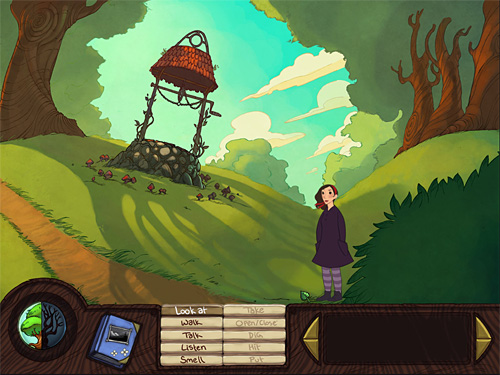 All in all, the development of Rosemary was a challenge throughout, but it was also tremendously enjoyable thanks to the wonderful students that stepped up to the challenge. Every discipline made wonderful contributions, making the game rich and enticing despite its brevity. The students were the ones who made this happen, and produced the game that you can now play. We hope you like it!
June 15, 2009 11:11 AM
Train of Thought
 I found myself, most uncommonly, at a loss for words. I found myself, most uncommonly, at a loss for words.
I had convinced myself, before we even sat down, that I knew what I was getting into - this was a game and I was the one in control. I listened to the chittering skeptic, the grumbling cynic latched on to the inner lining of my stomach that has been there for so many years, and I said aloud "I'd like to see the other game if we could..." having already started crafting the clever ways I would politely tear this horrifying, and dangerous idea to proverbial shreds. As we began playing, the layers of meaning unfolded, and the indigestion of my doubt began to quiet. With each roll of the dice, with every turned card, with every tiny forward lurch grinding wheels against tracks, my eyes and heart opened, I sank deeper into my chair, and a gaping wound was fingered. Most uncommonly:
I found myself at a loss for words.
Play Brenda Brathwaite's Train and forget what you think you know about "games." Play Brenda Brathwaite's Train and remember why, in the grandest of senses, we are here. Play Brenda Brathwaite's Train and remember because remembering, the very act of first knowing again, is our most important human faculty.
I wanted to tell Brenda, right then and there, why it was important, though I suspect she already knew. I wanted to articulate clearly and eloquently what I felt, to the person who so clearly articulated to me, through the power of her work, what she obviously felt and continues to feel. The academic in me was still able to craft logical arguments stating, this lead to that, and this assumes that, and if this then that therefore this and subsequently ta da. Tidy. But standing there, shaking her hand, or perhaps holding it, the only clear word I could muster, the word that was formed by my thumping, pulsing engine not my ticking jolting nerve center, seemed then, not quite right, but today, the best I could find. The only word that could try to say "thank you" and "how?" and "why?" and "I know" and "It's ok, is it ok?" and "I'm sorry" and perhaps most resoundingly "never again" all together in one massively, all-encompassing, super-powered word; it was the king of all words, the meteoric explosion of meaning in the singularity of one word:
Valuable.
Writing it now on this page it again seems insufficient. I am slowly coming to terms with the fact that it is very hard, nay impossible to make real with words what exists in the domain of feelings. How can it possibly compare to experience? These shoddy symbols, these crossed t's and dotted i's, cannot assume the overwhelming responsibility of making manifest my emotions. The unspeakable cannot be spoken, and so I apologize, to you Brenda, to you the reader, to any who have not yet enjoyed the true privilege of experiencing what I experienced a few days ago, for at this point I am again, quite uncommonly, at a loss for words.
June 8, 2009 10:00 AM
Why I Like Stupid Game Stories.
****WARNING - SPOILERS FOR BIONIC COMMANDO (2009) FOLLOW****
In a previous blog post I explained why I felt Grin's Bionic Commando was a well-designed 3D update of an old school classic, in spite of getting a bum rap from critics. Now that I've finished the game I feel like defending another aspect that's gotten pummeled by the gaming press: the story. While I'm not about to claim the story for Bionic Commando isn't silly, I don't find it to be nearly as random or meaningless as critics have claimed. While it seemed disappointingly slight for most of the game, I have to confess that the ending--while abrupt--did have a certain, unexpected dramatic logic that put the rest of the plot in perspective.
I had read several reviews that cited the ending as being sudden, stupid, and meaningless. So I was preparing myself. Although I disagreed with most critics about the gameplay, the criticisms of the story as being adolescent, techno-futuristic military nonsense didn't seem so off. A certain level of kitch was undoubtedly intentional (this is a sequel to a game that featured purple Nazi's and an undead version of Hitler, after all), but I can't say I cared for the overtly and seemingly un-ironic tone the game was striking as a macho power fantasy. It's hard to use kitch as your alibi when your protagonist is constantly screaming like a roid-raging jock ("Yeah, suck on that!") in a way that is obviously meant to be a "reward" for the player. That's never how I imagined Spencer when I played the original NES game as a 12-year-old, so playing Grin's update was a mixture of pleasure at seeing the world and characters extended but also frustration at seeing them fall victim to modern video game stereotypes. It also didn't help that the actual plot seemed to involve very few meaningful events and in general advanced very little over the course of the game. Basically the whole game boils down to you finding and stealing this weird canister that Super Joe wants, and then being betrayed by Joe who defects to the terrorists and uses the canister to initiate some weird master plan--called Project Vulture--which is never really explained.
Given the thin narrative set-up and obnoxious protagonist I wasn't holding out for a very satisfying ending, but I found myself liking it. It was indeed abrupt and the twist with Spencer's wife was goofy, but... I dunno. I guess what I liked was how the game built up to a simple, emotional moment and then just ended. I was thinking the whole game that the plot seemed strangely in the background, like there was all this complex stuff going on but it never really seemed to manifest in any coherent way. Although I'm sure lazy writing and a "game first, story second" development mentality probably contributed to this feeling, it all suddenly seemed to make sense given the climactic final moment.
If you look at Spencer as someone who really doesn't care about a goddamn thing except finding out what happened to his wife--not about what Project Vulture is, not about who the mysterious sniper is, not about Mag, not about saving the country--then the final sequence, where he chases Joe into the sky for apparently no other reason than to force him to explain his wife's death, makes a certain amount of sense as a narrative climax. The fact that Emily was somehow "used" to create Spencer's arm had been obviously hinted at, and in light of reviews I'd read I expected the reveal of this plot point to be a big, cheesy display. But it wasn't. I liked how Spencer screams at Joe to tell him what happened, how Joe refuses, and how Spencer smashes his face into putty and crushes the mysterious canister in a selfish rage, causing a massive explosion. You get the distinct impression Spencer killed Joe and wiped out his army not for any greater good but because of sheer personal hatred. It's an unexpected moment that almost makes the goofy story feel character-driven.

Spencer's sole motivation is to confront Joe.
I like how they never say straight out what happened to his wife, and I like the implication that, in the end, Spencer knows but doesn't want to face it, which is why he kills Joe. One of the reasons this seems like an interesting ending, rather than a cop-out ending, is that it isn't twisted into some feel-good Hollywood resolution. The only resolution is Spencer finding out what happened to his wife and then losing his mind as a result. It's not even clear whether or not he lives in the end. The final shot is of him falling silently to earth, assumedly not caring whether he lives or dies anymore. For such a macho game, which tries so hard to ape the feel of hyper-masculine Hollywood cinema, the sudden nihilism of the ending is striking. Most video game badasses don't end up being consumed by their own hatred and committing suicide an instant before the credits roll.

The End?
If I were to give the writers more credit than is due (and I probably am, but what the hell) I'd say that Spencer's relationship with his bionic arm--and the player's relationship with the arm--is intended somewhat as an expression of his relationship with his wife. One thing that stood out for me was how Spencer's characterization in-game was different than in cut-scenes. In cut-scenes he's always sullen, but in-game he's always screaming his pleasure any time he does something amazing with the arm. For a guy who hates his life he clearly loves to swing around, take giant leaps, and soar through the sky. The first time he sees the arm he smiles, suggesting that--even though he doesn't give a shit about Joe or the mission--the thought of being with his arm again is enough to win him over. As both the cinematics and gameplay constantly remind you, his arm is the only thing that makes him feel alive, which, in light of the final plot twist, appears to be a subtle kind of foreshadowing.

Spencer's last memory of Emily.
I feel moderately embarrassed defending the narrative and thematic virtues of Bionic Commando. On the surface the story is both slight and silly, and the game's muscle-bound macho-man attitude is not something I'm a fan of. However, I do think the ending is weird enough, and the story decisions probably deliberate enough, that it's fair to take the story (just like the gameplay) on its own terms and accept that perhaps there's a method to its madness. I'm not arguing for it being art so much as I'm arguing that the story and themes are not devoid of logic or purpose, as many reviewers have suggested.
I think, ultimately, what I liked about the ending is how, in its overwhelming of gameplay logic with dramatic logic, it hearkened back to the original Bionic Commando, moreso than Rearmed did. Rearmed was a great remake in many ways, but one thing I didn't like is how it turned the emotionally-fueled finale of the original into a series of "proper" gameplay challenges. The original Bionic Commando's ending was great because it wasn't hard, but because it gave the player a series of easy challenges that seemed motivated by nothing more than the dramatic momentum of the story. Destroying the Albatross, killing Master D, and escaping the complex were all easy, hence there was nothing to distract you from the dramatic feeling of the moment. The final sequence of the next-gen Bionic Commando, with you soaring into the sky after Joe, dispatching winged goons on the way in marvelously epic fashion, offers the same sort of dramatics-over-gameplay thrill. There is no "proper" last boss fight in Bionic Commando like there (disappointingly) was in Rearmed. There is just the final confrontation with Joe, in which all of Spencer's pent up angst--quite literally--explodes.

The final, thrilling flight to the heavens.
One last thing: the stuff with Spencer's wife's brain (or brain pattern--it's kind of unclear) being "used" to make his bionic arm is indeed silly, but I suppose I don't find it as shatteringly dumb as some people do because it seems derived from the metaphysics one often finds in Japanese science fiction (remember, although Grin is a Swedish developer, Bionic Commando is originally a Japanese franchise, and Capcom was involved in the production). Specifically it reminded me of an anime I saw a long time ago called Roujin Z, about a medical robot "possessed" by the dead wife of the old man it is caretaker of. The notion of the mind, the self, or the soul being embodied in a machine and connecting with another person's "soul" through some technological interface is common in anime/manga sci-fi. It's the entire basis for Ghost in the Shell, the seminal Japanese cyberpunk that Grin's Bionic Commando owes more than a little to. I'm not claiming that it's brilliantly written, but this plot twist does not seem like random bad writing to me so much as a symptom of the East-meets-West genre cross-pollination that, in general, makes Bionic Commando more interesting and quirky than your typical Western action game.
June 4, 2009 3:54 PM
GAMBIT on ThirtyOn10.
A few months ago, a group of Boston University students invited some members of our lab to appear in an episode of ThirtyOn10, "a weekly news program produced by the Broadcast Journalism Graduate Students of 2009". The episode, which focused on the video game industry and its impact upon Boston, featured not only GAMBIT people Philip Tan, Clara Fernández-Vara, Matthew Weise, Marleigh Norton, Shota Nakama and Jonathon Georgievski, but a ton of B-roll footage from the lab and an entire segment interviewing friend of the lab Darius Kazemi. All five parts of the episode have been uploaded to YouTube, and you can check them out below.
Nice work, folks, and thanks for including us in your project!
June 1, 2009 2:00 PM
GAMBIT's Phorm at E3!
For those of you lucky to be running around at the Electronic Entertainment Expo in Los Angeles this week, keep an eye open for our summer 2008 prototype game Phorm, which is being featured in the IndieCade Independent Games Showcase! Posted below is the official press release from IndieCade.
IndieCade @ E3: An Indie Games Showcase
What is the IndieCade International Festival of Independent Games?
- IndieCade is the only stand-alone Independent Game Festival in the Nation. It is also the only event of its type open to the public. It is a completely international event.
- IndieCade holds an annual juried competition that culminates in its annual Festival.
The 2009 Festival will be held in Culver City, California, October 1- 4, 2009.
The festival will include an interactive exhibition of finalist games, premiere screenings, live gameplay, a conference, salons, workshops, artist talks, performances, and more.
The IndieCade 2009 Festival is programmed to serve the gamemaking community, the industry, consumers of independent media, digitally energized youth, and the general public. Culver City is located between Hollywood, Santa Monica, and Downtown Los Angeles.
What are the IndieCade Showcase Events?
What is IndieCade's Mission?
- IndieCade supports independent game development and organizes a series of international festivals and showcase exhibitions for the future of independent games. It encourages, publicizes, and cultivates innovation and artistry in interactive media, helping to create a public perception of games as rich, diverse, artistic, and culturally significant. IndieCade's events and related production and publication programs are designed to bring visibility to and facilitate the production of new works within the emerging independent game movement. Like the independent developer community itself, IndieCade's focus is global; it includes producers in Asia, Europe, Australia, and wherever independent games are made and played. IndieCade was formed by Creative Media Collaborative, an alliance of industry producers and leaders founded in 2005. Advisors to IndieCade include Dave Perry, Will Wright, Eric Zimmerman, Neil Young, Tracy Fullerton, and Keita Takahashi, among many other storied industry veterans and rebels.
What do we mean by independent?
- Simply put, independent games are games that come from the heart, that follow a creative vision, rather than a marketing bottom line. Independent developers are not owned by or beholden to a large publisher. This means that they generally have smaller budgets than mainstream games (often no budget at all!), but they also have the freedom to innovate and to enlarge our conception of games and game audiences. Indie developers can run the gamut from artists, to academic researchers, to students, to emerging development studios striving to make the next big indie hit. They can be one person or a large team. They may be internally funded, funded by grants or private investors, or not funded at all! The key is that they create games based on their own unique vision.
What is IndieCade doing at E3?
- We were invited to curate this exhibition in order to showcase and promote innovation in the game industry. We also help to expose publishers to new independent voices. We work closely with the ESA, the IGDA and other organizations interested in supporting the cause of independent game creation. We share the goal of these organizations to showcase the present and future of video games as a culturally significant form of expression.
How were the games for the E3 Independent Games Showcase Selected?
- The showcase was curated by IndieCade co-chairs Celia Pearce and Sam Roberts and Creative Media Collaborative CEO Stephanie Barish. The games were primarily drawn from the 2009 Submissions to IndieCade and we included a few successful games from last year's selection that are otherwise not possible to see. The criteria for this showcase was to put together a diverse array of games that would showcase innovation for the mainstream game industry and game press, represent a wide array of independent game developers, and highlight works to come later this year.
Who are the developers?
- The developers represented here include individuals, small teams, independently owned studios, universities and their faculty and students. Developers come from around the world including the US, Belgium, Spain, Austria, Great Britain and others.
Are any of these games slated for mainstream publication?
- Last year a number of games shown by IndieCade were picked up by major publishers such as Nintendo, Xbox, and Sony, as well as multiple digital distribution platforms. Other games were selected for Museum installations and other artistic venues. So, don't be surprised to see some of the titles at our showcases and festival as commercial games in next year's E3.
IndieCade @ E3: An Indie Games Showcase
Hands-On Demos
And Yet It Moves*
And Yet It Moves Team
*(2007/2008 Official IndieCade Selection, Coming to Nintendo Wii Soon!)
Blueberry Garden*
Erik Svedäng/Sweden
*(2008 Official IndieCade Selection, 2009 IGF Awardee)
Closure
Tyler Glaiel & Jon Schubbe/United States
Cogs
Lazy 8 Studios/United States
Dear Esther
thechineseroom/United Kingdom
Flywrench* & Cowboyana
Messhof, Mark Essen/United States
*(2008 Official IndieCade Selection, Currently on display at New Museum, New York)
Global Conflicts: Latin America
Serious Games Initiative/Denmark
Octopounce
Auntie Pixelante/United States
Papermint
Avaloop/Austria
Snapshot
RetroAffect/United States
Winds of Orbis: An Active-Adventure
Deep End Interactive/United States
Zephyr: Tides of War
Florida Interactive Entertainment Academy/United States
Alternate Reality, Live Games, and Installations
The Deep Sleep Initiative
ARx/United States
Mightier
Lucas Pope & Keiko Ishizaka/United States
Pluff
Diana Hughes/United States
Prototype161: Agents Wanted
Prototype 161/United States
Mobile
AquariYum!
Teatime Games/United States
Bobobua
Tripod Games/China
Guru Meditation
Ian Bogost/United States
Ruben & Lullaby
Erik Loyer/United States
Games on Video
Fabulous/Fabuleux
Lynn Hughes & Heather Kelley/Canada
Gray
Mike Boxleiter & Greg Wohlwend/USA
Posemania
Anthony Whitehead, Hannah Johnston, Kaitlyn Fox, Nick Crampton, Joe Tuen/Canada
Phorm
Singapore-MIT GAMBIT Game Lab/United States & Singapore
When The Bomb Goes Off
Tom Sennett/United States
Art Exhibition
For this year's E3, IndieCade selected games from past years to present high-resolution prints of screenshots. Below is a list of art on display and the artwork being showcased.
Braid*
Jon Blow & David Helman/United States
*(2007 IndieCade Offiial Selection, Xbox Live Arcade)
Blueberry Garden*
Erik Svedang/Sweden
*(2008 IndieCade Official Selection, 2009 IGF Awardee)
The Endless Forest - ABIOGENESIS
Tale of Tales/Belgium
Freedom Fighter '56
Lauer Learning/United States
ioq3aPaint
Julian Oliver*/Spain
*(2008 IndieCade Awardee, Technical Innovation)
Machinarium*
Amanita Design/Czech Republic
(2008 IndieCade Awardee, Aesthetics, 2009 IGF Design Awardee)
The Misadventures of P.B. Winterbottom*
The Odd Gentlemen/United States
(2008 IndieCade Awardee, World/Story, Distribution to be announced Shortly)
The Night Journey*
Bill Viola Studio and USC/United States
*(2008 IndieCade Awardee, Sublime)
Nobi Nobi Boy Collage
Keita Takahashi*/Japan
*(IndieCade Board of Advisors)
Passage*
Jason Rohrer/United States
*(2008 IndieCade Awardee, Jury Selection)
Rooms*
Hand Made Games/Korea
*(2007 Official Selection, Available on Big Fish Games)
Ruckenblende*
Die Gute Fabrik (the good factory)/Denmark
*(2008 IndieCade Awardee, Gamemaker's Choice)
The Unfinished Swan
Ian Dallas/United States
Where is My Heart?
Bernhard Schulenburg/Germany
IndieCade Sponsors, Supporters, and Partners
The Culver Hotel
The City of Bellevue, Washington
The City of Redmond, Washington
Electronic Entertainment Design and Research (EEDAR)
The Entertainment Software Association (The ESA)
GameCity, Nottingham
Gregg Fleishmann Gallery
The International Game Developers Association (IDGA)
Gaming Angels
IDG World Expo
Imago imaging
Jon Burgerman
Open Satellite Gallery
M Café de Chaya
Mary Margaret Network
Royal-T
Rush Street
Signtist
SIGGRAPH
The Wonderful World of Animation Gallery
June 4, 2009 10:00 AM
A Guy's Defense of Guy-Bashing Game Criticism.

I don't read game blogs as much as I should, which is why I was not fully aware of the backlash Heather Chaplin got for her GDC rant this year. It seems that several prominent bloggers gave her some real shit about what she said, and I want to pipe up and defend her a bit. I understand how one could be upset by her fiery rhetoric and judgmental attitude, but I really feel like a lot of her critics missed her point.
I took Heather's point to be that game developers have no one to blame but themselves for the preponderance of male power fantasy-oriented game culture, and that hiding behind the popular excuse that the medium somehow "isn't there yet", either technically or artistically, is both cowardly and disingenuous. This was all summed up in her opening statement: the medium isn't immature; you are.
I didn't find this offensive in the slightest, mostly because it jibes pretty easily with my experience of working at a commercial game company. I didn't feel Heather was talking about me personally. I felt like she was talking about a certain kind of person who works in games, the sort who likes to disguise the bankruptcy of his own imagination with lame excuses, the sort who would say "Hey, I had no choice but to make a bloody game with floppy tits! The medium's not art yet! It's not my problem!"
People with this attitude I feel deserve all the smackdown Heather can dish out. Not because they enjoy male power fantasies, but because they don't take any responsibility for enjoying them. I didn't take her to be saying that all men who enjoy such fantasies are hopelessly childish, but that it is childish to enjoy such fantasies and pretend like they are not childish. The male-dominated games industry needs to own up to the sort of culture it is perpetuating and not try to weasel out of any debate that would hold them responsible for facilitating and maintaining these cultural norms. They need to call a spade and spade and understand that this is a choice they are making in design meetings, in marketing meetings, etc. It isn't some mystical phenomenon they have no control over. They have complete control over it. At the end of the day our current game culture is what they've created. It's didn't create itself.
Simply admitting that, owning that, acknowledging that responsibility--that's what I felt Heather was really calling for in her angry rant. That's maturity. That's what "real men" would do. It's not that creating or indulging in male power fantasies is somehow inherently wrong, but nurturing a culture based around them as the dominant form of gamer culture and then turning around and saying "Hey, it's not our fault!" is cowardly. It's a patronizing slap in the face to anyone who feels under-represented by the current culture. Mature adults (male or otherwise) should have more integrity than that. And when you're dealing with people of integrity - who enjoy blowing shit up but realize that's not what everybody wants - you have the possibility for real dialogue and real change.
|
 |
